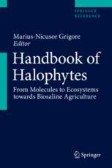Search
Search Results
-
Chemical sedimentation as a driver of habitat diversity in dryland wetlands
Freshwater wetlands located in dryland environments are characterised by high evapotranspiration rates and frequent periods of desiccation, which...

-
A new species of genus Lunovula Rosenberg, 1990 (Gastropoda: Pediculariidae) from China Seas, the first pediculariid found feeding on a tree hydroid
A new species of the genus Lunovula Rosenberg, 1990 , Lunovula su**ae sp. nov. feeding on deep-sea hydroid Solanderia sp. (Solanderiidae, commonly...

-
Plant species associations with alkaline environments associated with artesian spring wetlands
AimsTo describe the physico-chemical environment of artesian spring wetlands and surrounding scalds; to identify the association of plant species...

-
Alkaliphilic, Alkalitolerant Microorganisms
Alkaliphilic microorganisms are those microbes that require alkaline pH for growth with optimum growth at pH 9.0. They cannot grow or grow only...
-
Siccirubricoccus phaeus sp. nov., isolated from oil reservoir water and emended description of the genus Siccirubricoccus
A Gram-staining-negative, non-motile, aerobic bacterium, designated 1–3 T , was isolated from oil reservoir water collected from Liaohe oilfield,...

-
Halophytes in Arts and Crafts: Ethnobotany of Glassmaking
The word glass is derived from a late Latin term glæsum used to refer to a lustrous and transparent material. Soda-rich plant ashes have been used in...
-
Investigating plant chemicals and trade-offs between adult preference and larval performance of the rice water weevil
Herbivores use plant chemicals for host plant selection to maximize their own and/or offspring performance. Since host plants that are optimal for...

-
Sizes, condition factors and sex ratios of the scattered populations of the small cichlid fish, Alcolapia grahami, that inhabits the lagoons and sites of Lake Magadi (Kenya), one of the most extreme aquatic habitat on Earth
Alcolapia grahami is a small cichlid fish that inhabits the scattered lagoons and sites of Lake Magadi (Kenya). Exceptional physiological,...

-
Microbial and Physical Sedimentary Structures in the Tidal Flats of Khor Al-Zubair, NW of Arabian Gulf
This present study deals with the microbial sedimentary structures which are mainly induced by the cyanobacteria in the tidal flats of Khor...
-
Poorly known microbial taxa dominate the microbiome of hypersaline Sambhar Lake salterns in India
Inland athalassohaline solar salterns provide unique opportunity to study microbial successions along salinity gradients that resemble transition in...

-
Electrophysiological Responses of the Mediterranean Fruit Fly, Ceratitis capitata, to the Cera Trap® Lure: Exploring Released Antennally-Active Compounds
The Mediterranean fruit fly (medfly), Ceratitis capitata , is a worldwide pest of agriculture able to use olfactory cues to locate habitat, food...

-
Nature and bioprospecting of haloalkaliphilics: a review
The haloalkaliphilics are an important subset of extremophiles that grow in salt [upto 33% (wt/vol) NaCl] and alkaline pH (> 9). They are found in...
-
Halophytes in Arts and Crafts: Ethnobotany of Glassmaking
The word glass is derived from a late Latin term glæsum used to refer to a lustrous and transparent material. Soda-rich plant ashes have been used in...
-
Limitations to Bambara Groundnut Utilisation
The potentials of Bambara groundnut for food and industrial applications have been recognized. Considering its nutrient profile and agronomic traits,...
-
Plant Volatiles and Their Role in Insect Olfaction
Plant volatiles are the invisible players in the plant-insect co-evolutionary arms race. They are involved in various plant-mediated tri-trophic...
-
Desert Biosignatures
This chapter describes the detection of molecular traces of life in endolithic microbial communities from the Preandean region of the Atacama Desert....
-
Biotechnology Contributing to Integrated Pest Management: The Example of Two Major Coconut Pests, Oryctes rhinoceros and Brontispa longissima
Pests and diseases are major limiting factors in coconut (Cocos nucifera L.) production. Pests ranging from insects to mites and diseases from fungi...
-
Potentials of silicate-based formulations for wood protection and improvement of mechanical properties: A review
Silica or silica-precursor systems are attractive for the protection of wood against biotic and abiotic damages and for improvement of the fire...

-
Salty, Alkali-Laced Tales (Mostly True) from the Great Basin Desert, California and Nevada
My career has managed to blend scientific inquiry with four decades of field work in the soda lakes of the Great Basin Desert. It has been quite an...
-
Coding and Evolution of Pheromone Preference in Moths
Olfaction is of overriding importance in defining the ecological niche of most insect species. Understanding the inner workings of olfaction can thus...
